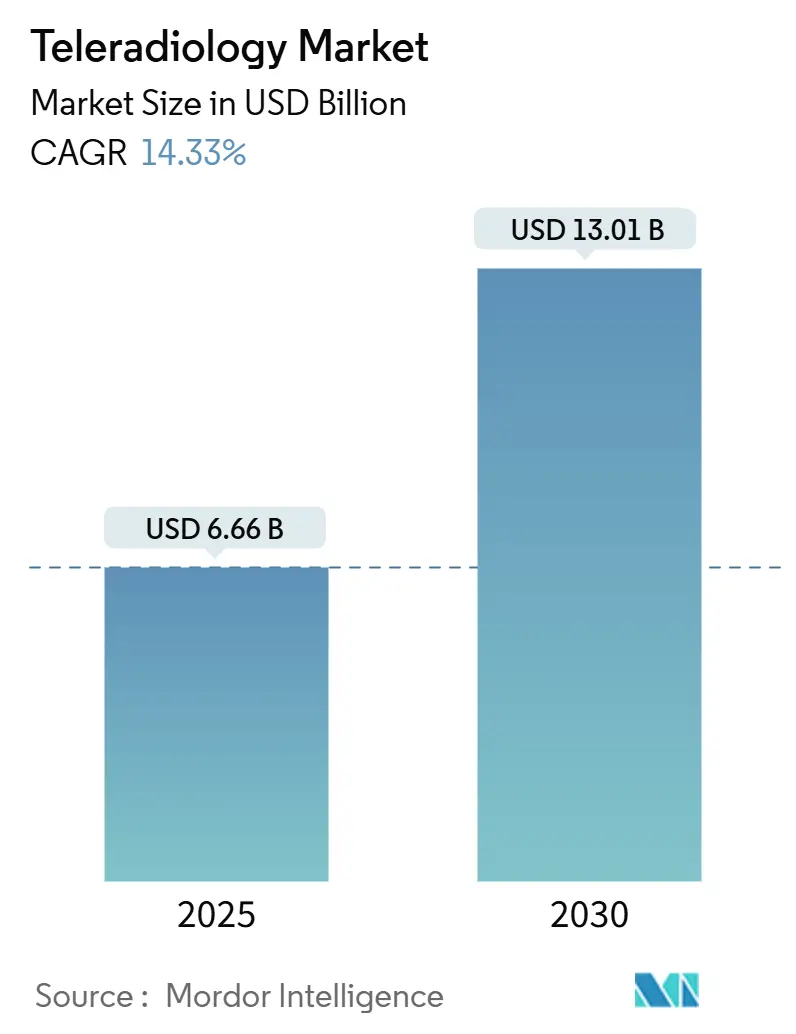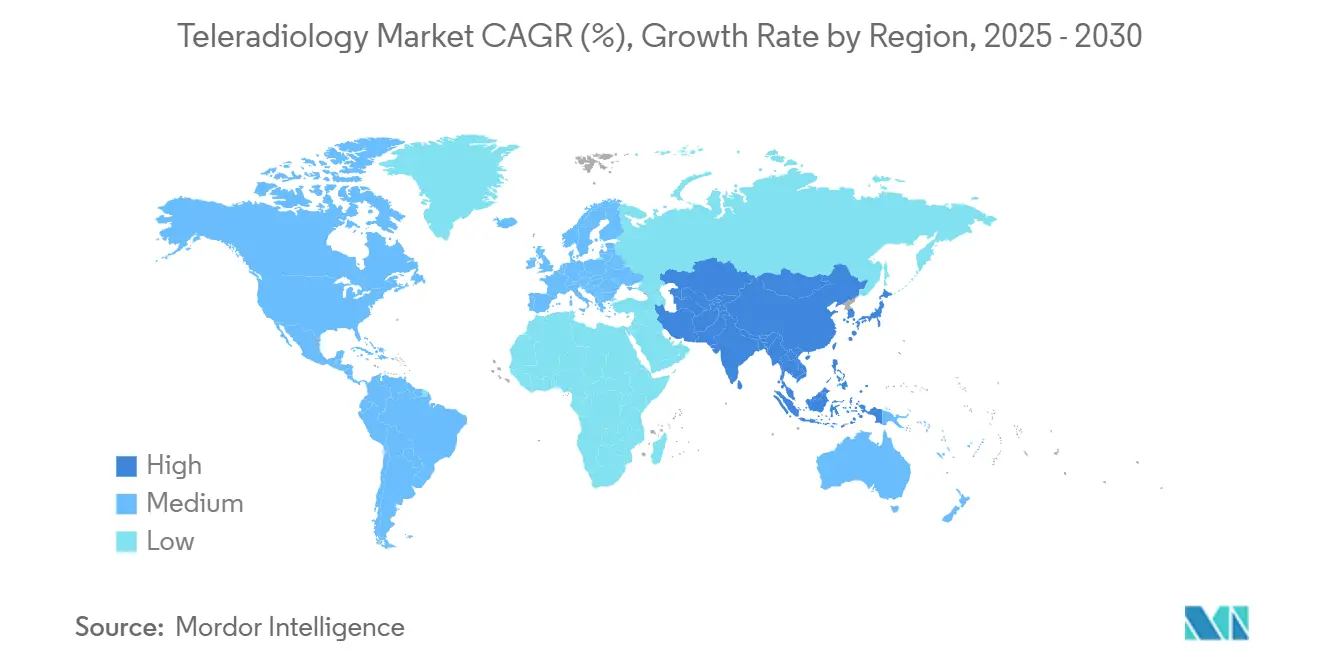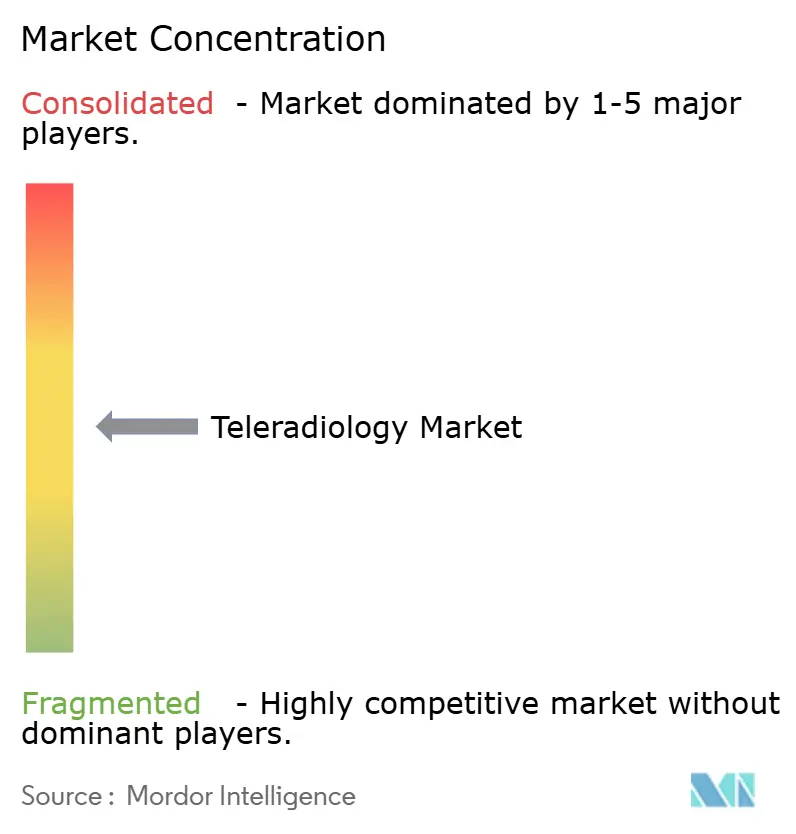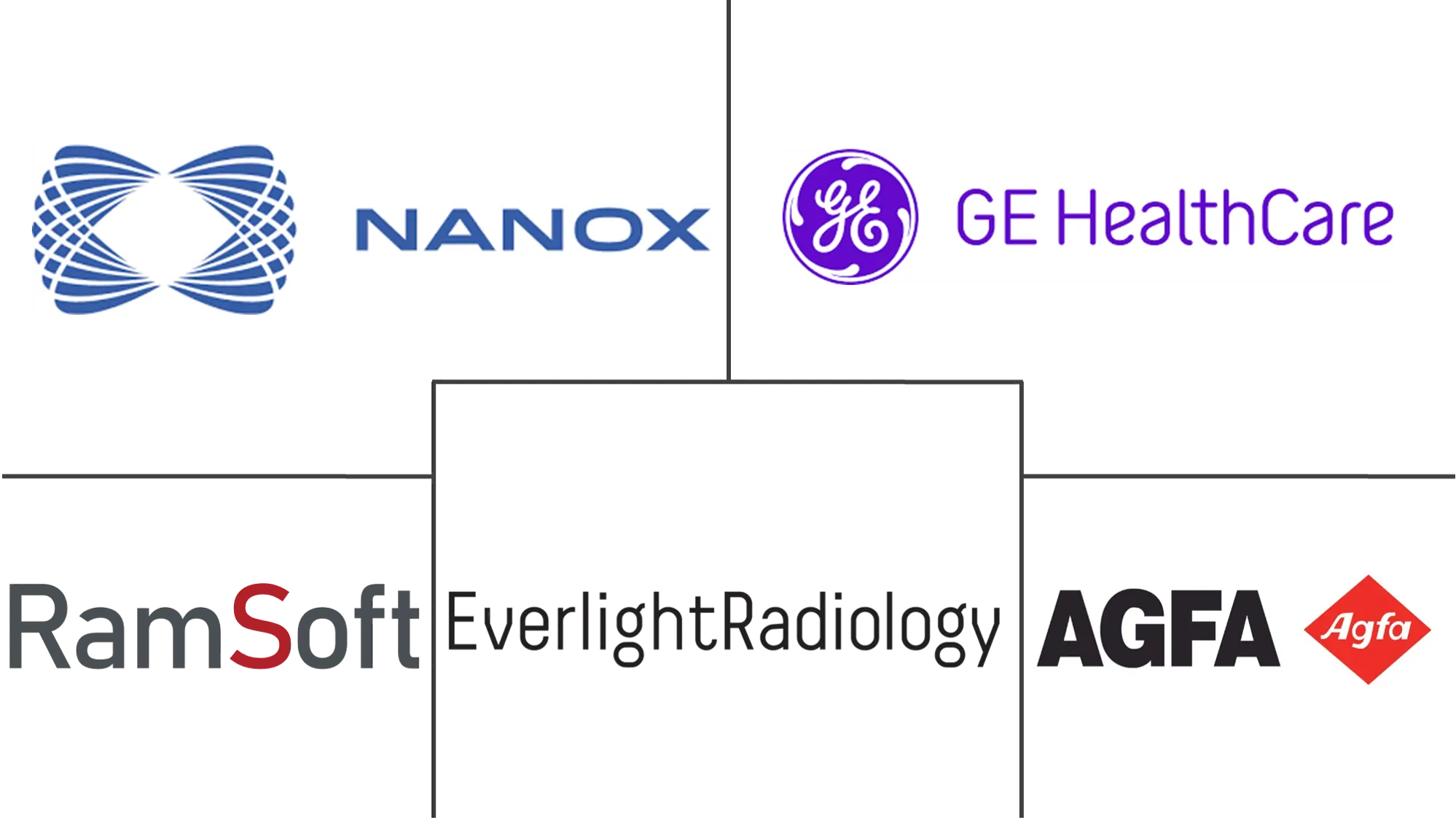Teleradiology Market Size and Share

Teleradiology Market Analysis by Mordor Intelligence
The Teleradiology Market size is estimated at USD 6.66 billion in 2025, and is expected to reach USD 13.01 billion by 2030, at a CAGR of 14.33% during the forecast period (2025-2030). The surge aligns with widening radiologist shortages, rapid broadband expansion, and cloud-first imaging platforms that convert once-optional remote reading into a core clinical utility. Workforce gaps—expected to leave the United Kingdom 40% short of radiologists by 2028—mirror similar deficits across OECD members and keep remote diagnostics in permanent demand. At the same time, radiology volumes continue to climb as aging populations require more cross-sectional imaging, driving health systems toward outsourced overnight coverage and subspecialty reads. AI-enabled triage and zero-footprint viewers reduce turnaround time and capital outlays, attracting providers seeking flexible growth.[1]Source: American College of Radiology, “Teleradiology,” acr.org Consolidation is accelerating: ONRAD’s January 2025 purchase of Direct Radiology created a scaled platform serving 550 sites and signalled to investors that teleradiology has moved from a fragmented service to a strategic infrastructure layer.
Key Report Takeaways
- By component, software held 40.54% of 2024 revenue; hardware is on track for the fastest 15.23% CAGR through 2030.
- By imaging technique, CT led with 32.62% teleradiology market share in 2024, while MRI is forecast to post a 14.99% CAGR to 2030.
- By end user, hospitals accounted for 58.13% of 2024 revenue; diagnostic imaging centers are set to expand at a 15.74% CAGR through 2030.
- By geography, North America dominated with 38.83% revenue in 2024; Asia-Pacific is projected to register the quickest 16.16% CAGR to 2030.
Global Teleradiology Market Trends and Insights
Drivers Impact Analysis
| Driver | (~) % Impact on CAGR Forecast | Geographic Relevance | Impact Timeline |
|---|---|---|---|
| Shortage of Radiologists in OECD Countries | +3.2% | North America & Europe, spillover to APAC | Long term (≥ 4 years) |
| Rising Global Diagnostic-Imaging Volumes | +2.8% | Global | Medium term (2-4 years) |
| Expansion of 5G & Satellite Broadband Connectivity | +2.1% | Global, with early gains in North America, Europe, APAC | Medium term (2-4 years) |
| AI-Enabled Work-List Triage Boosting Reading Capacity | +1.9% | Global | Short term (≤ 2 years) |
| Overnight "Follow-The-Sun" Service Outsourcing | +1.7% | Global | Short term (≤ 2 years) |
| Cloud-Native Zero-Footprint Viewers Reducing CAPEX | +1.5% | Global | Short term (≤ 2 years) |
| Source: Mordor Intelligence | |||
Shortage of Radiologists in OECD Countries
Demand for imaging is climbing 27% over three decades, yet radiologist headcount growth is flat, leaving hospitals without round-the-clock coverage, especially in neurology, musculoskeletal, and cardiothoracic subspecialties. Remote reading fills both geographic and temporal gaps, supports emergency departments, and appeals to younger physicians who prioritize flexible schedules. Rural and underserved regions, in particular, rely on remote diagnostics because running an in-house radiology department is cost-prohibitive. The structural nature of the shortage ensures long-term demand for teleradiology services.
Rising Global Diagnostic-Imaging Volumes
Projected 2055 modality growth—CT 25.1%, nuclear medicine 26.9%, X-ray 17.8%, ultrasound 17.3%, MRI 16.9%—adds pressure on health systems already grappling with staffing constraints. Chronic diseases, aging demographics, and expanded screening initiatives drive the volume uptick. Teleradiology allows facilities to absorb workload spikes without proportional payroll growth and ensures subspecialists interpret complex cases without patients travelling to tertiary centers.
Expansion of 5G & Satellite Broadband Connectivity
Low-earth-orbit constellations now deliver 50-56 Mbps to remote sites, shrinking latency and allowing live image transfer from previously disconnected clinics.[2]Source: Lifetrack Medical Systems, “Starlink’s Potential Impact on Remote Radiology,” lifetrackmed.com Coupled with 5G, the infrastructure lets teleradiology providers enter emerging markets quickly, support trauma and stroke imaging, and widen service portfolios to include real-time consultations. These connectivity improvements enable teleradiology expansion into markets where infrastructure limitations previously prevented service delivery, creating new revenue opportunities for established providers while improving healthcare access in underserved regions. The reduced latency particularly benefits time-sensitive applications like stroke imaging and trauma cases where diagnostic delays directly impact patient outcomes.
AI-Enabled Work-List Triage Boosting Reading Capacity
Generative AI can suppress 53% of cases requiring manual review, shrinking report turnaround and halving error rates through automated quality checks. Vendors claim 90% fewer dictated words for routine reports, freeing specialists to focus on complex pathology. These gains translate into faster service levels, elevating provider competitiveness and reinforcing AI as a central purchase criterion. This technology adoption creates competitive advantages for teleradiology providers that can offer faster turnaround times and enhanced diagnostic accuracy compared to traditional radiology practices.
Restraints Impact Analysis
| Restraint | (~) % Impact on CAGR Forecast | Geographic Relevance | Impact Timeline |
|---|---|---|---|
| Cyber-Security & Data-Sovereignty Concerns | -2.3% | Global, particularly Europe and Asia-Pacific | Medium term (2-4 years) |
| Multi-State Licensure and Credentialing Hurdles | -1.8% | North America, with spillover effects globally | Long term (≥ 4 years) |
| Satellite-Link Latency in Remote Areas | -1.2% | Global, particularly rural and developing regions | Short term (≤ 2 years) |
| Organized Radiologist-Union Pushback in Europe | -0.9% | Europe | Medium term (2-4 years) |
| Source: Mordor Intelligence | |||
Cyber-Security & Data-Sovereignty Concerns
In 2024, 88% of healthcare entities reported a breach, affecting 106 million Americans. Legacy PACS lack modern safeguards, and ransomware has caused downtimes exceeding a month and losses above USD 63 million. Strict frameworks such as GDPR elevate compliance costs for cross-border reads, prompting buyers to vet vendor security posture rigorously and favor partners offering cyber-insurance and sovereign-cloud deployment options.
Multi-State Licensure and Credentialing Hurdles
U.S. radiologists must hold a license in both the imaging site’s state and their reading location, adding administrative overhead, renewal fees, and months-long credentialing queues. International guidelines are equally stringent, limiting cross-border teleradiology even when technology is ready. Smaller providers struggle with compliance costs, tilting competitive advantage toward large networks with dedicated legal teams.
Segment Analysis
By Component: Software Dominance Drives Cloud Migration
Software solutions generated 40.54% of 2024 revenue, a position underpinned by subscription models that cut capital outlays and provide automatic upgrades. These cloud platforms integrate AI modules, zero-footprint viewers, and vendor-neutral archives that clinicians can reach on any device. GE HealthCare’s Genesis portfolio exemplifies this move toward elastic infrastructure that synchronizes multisite workflows. Hardware, representing on-premise servers, high-resolution workstations, and network equipment, is set to post the briskest 15.23% CAGR as 5G gateways and edge devices proliferate and as rural hospitals add satellite receivers to link with metropolitan reading hubs. Service contracts keep expanding as outsourcing becomes mainstream, but the teleradiology market size for services scales steadily rather than explosively because buyers blend vendor assistance with in-house IT teams.
The software wave creates cost savings near 30% by eliminating data-center maintenance and unlocking pay-as-you-go scalability. Vendors differentiate by embedding AI orchestration that routes studies based on priority and subspecialty, reducing idle time and failed handoffs. Hybrid cloud-edge designs ensure image pre-processing happens locally, then the study transfers securely to public clouds for AI inference, an architecture that satisfies privacy obligations while preserving bandwidth. As a result, facilities across mid-income countries can spin up full-featured imaging solutions without multimillion-dollar infrastructure, widening the addressable teleradiology market.

Note: Segment shares of all individual segments available upon report purchase
By Imaging Technique: CT Leadership Meets MRI Innovation
Computed tomography accounted for 32.62% revenue in 2024, reflecting its indispensability across trauma, oncology staging, and lung screening. Standardized protocols allow streamlined remote reading, supporting emergency departments that need sub-30-minute turnaround. The modality’s entrenched reimbursement codes and ubiquitous scanner base shield it from disruptive swings. The teleradiology market size for CT continues to benefit from algorithmic noise-reduction techniques that cut radiation dose, thereby expanding usage windows into pediatrics and serial follow-up.
Magnetic resonance imaging is projected to climb at a 14.99% CAGR, the fastest among modalities. AI-enhanced segmentation and automated quantification shorten scan times and simplify interpretation, letting rural facilities capture complex neuro and ortho studies and forward them to subspecialist radiologists. Helium-free compact systems reduce siting costs, unlocking new buyer cohorts. Ultrasound’s point-of-care surge and AI-driven lesion characterization keep it relevant, while X-ray remains foundational for primary care and urgent clinics. Nuclear imaging, though niche, commands high margins in oncology where tracer specificity demands expert reads seldom available on site.
By End User: Hospital Consolidation Drives Imaging Center Growth
Hospitals controlled 58.13% of 2024 revenue, the largest teleradiology market share, because they use remote reads for overnight coverage, subspecialty consultations, and multi-site coordination that keeps quality consistent across the network. Their mature purchasing teams, integrated IT systems, and established reimbursement pathways let them embed cloud viewers and AI triage tools without disrupting clinical workflows. Many large systems now run core daytime reading internally but lean on teleradiology to handle peaks and rare subspecialties, preserving staff productivity and patient safety standards. Teaching hospitals also rely on remote reads to expose residents to a wider mix of cases and expert feedback, strengthening academic programs. These factors keep hospitals at the center of the enterprise imaging ecosystem even as financial pressures push them to optimize every scan’s cost.
Diagnostic imaging centers are expanding fastest, with a 15.74% CAGR to 2030, as they tap teleradiology partnerships for subspecialist reads while avoiding the payroll burden of full-time radiologists. Outpatient imaging volumes are expected to rise 13% a year, especially for CT and PET, which lifts the teleradiology market size for these centers without forcing major capital outlays. Private equity has recognized the model’s scalability, evident in Affinity Equity Partners’ USD 658 million buyout of Lumus Imaging in Australia, signalling confidence in distributed diagnostic networks. Urgent-care chains and specialty clinics are following suit; Experity’s FDA-cleared AI fracture-detection tool shows how targeted software can plug into remote reading workflows and open new revenue streams.

Note: Segment shares of all individual segments available upon report purchase
Geography Analysis
North America led with 38.83% revenue in 2024 on the back of Medicare coverage, robust fiber networks, and established malpractice frameworks that reassure buyers. However, looming 3-4% Medicare fee cuts in 2025 pressure hospital margins, prompting administrators to accelerate cost-saving remote reads. Private equity remains active: RadNet’s USD 103 million iCAD acquisition augmented its AI breast-imaging toolkit, reinforcing scale advantages. Canada and Mexico adopt cross-border teleradiology for night coverage, leveraging bilingual radiologists to smooth regional workflow.
Asia-Pacific is forecast for a 16.16% CAGR, the highest worldwide. Government programs in China and India subsidize PACS rollouts and broadband to primary health centers, while middle-class growth fuels demand for high-resolution MRI and CT. Investments in AI for MedTech are projected to hit USD 250 million by 2028, and companies such as RamSoft have planted regional hubs to serve multilingual clients. Australia’s I-Med Radiology Network, valued near USD 2 billion, showcases investor appetite for regional consolidation.
Europe maintains steady momentum as 84% of EU members already employ teleradiology in some form. Yet data-sovereignty rules and union resistance temper velocity. The United Kingdom’s Hexarad—backed by EUR 13 million in growth funding—adds over 200 radiologists to its roster, illustrating how platform plays can thrive even in regulated environments. Germany’s outpatient clinics show positive attitudes, with 79.2% of referring physicians rating remote reading favorably, pointing to unmet demand in rural districts.[3]Source: Diagnostics Journal, “Radiology Access in Rural Germany,” doi.org

Competitive Landscape
Teleradiology remains moderately fragmented. The top five providers control substantial portion of global invoice value, leaving room for regional specialists focused on trauma, pediatrics, or night-hawk services. Consolidation accelerated in 2025 when ONRAD merged Direct Radiology into its network, stretching coverage to 550 sites and signalling a race toward scale economics. Rad AI’s USD 60 million raise at a USD 525 million valuation underscores how AI performance now differentiates vendors by reducing fatigue and tightening report quality.
Technology partnerships multiply: GE HealthCare collaborates with AWS on generative AI and with NVIDIA on autonomous imaging, combining hyperscale cloud with specialized hardware to slash inference latency. Siemens Healthineers and Sectra sealed a radiology data-sharing partnership in February 2025, signalling incumbent equipment makers’ urgency to offer end-to-end remote reading stacks.
Barriers to entry rise as hospital systems pivot to multiyear platform contracts covering AI, cloud PACS, cybersecurity, and subspecialty staffing, limiting opportunities for ad-hoc night-hawk boutiques. Yet niche players prosper by targeting urgent care centers, orthopedic clinics, and mobile mammography fleets that value specialized workflows. Advanced vendors wrap cybersecurity guarantees, sovereign-cloud hosting, and credentialing support into single-fee packages, appealing to compliance-conscious buyers in Europe and Asia.
Teleradiology Industry Leaders
-
Agfa-Gevaert Group
-
Everlight Radiology
-
RamSoft Inc.
-
Nanox Imaging LTD (USARAD.COM)
-
GE HealthCare
- *Disclaimer: Major Players sorted in no particular order

Recent Industry Developments
- May 2025: Konica Minolta Healthcare Americas and NewVue unveil Exa Teleradiology, an AI-driven workflow platform that unifies multi-facility worklists.
- February 2025: ZettaHealth launches Z-Suite, an ERP/BIS tailored for professional reading groups and fee-for-service billing.
- September 2024: Experity integrates FDA-cleared AI for fracture detection into its urgent-care teleradiology over-read services.
- April 2023: Aster DM Healthcare opened its Telecommand Center and Digital Health facility in India, which uses cutting-edge technology to provide all telehealth services under one roof, including teleradiology.
Global Teleradiology Market Report Scope
Teleradiology is the transmission of images such as X-rays, CTs, and MRIs to share information with radiologists or physicians from one location to another. The teleradiology market is segmented by Imaging Technique [X-rays, computed tomography (CT), ultrasound, magnetic resonance imaging (MRI), nuclear imaging, and other imaging techniques], component (hardware and software), end user (hospitals, diagnostic centers, and other end users), and geography (North America, Europe, Asia-Pacific, Middle East and Africa, and South America). The market report also covers the estimated market sizes and trends for 17 countries across major regions globally. The report offers the value (in USD) for the above segments.
| Hardware |
| Software |
| Services |
| X-ray |
| Computed Tomography (CT) |
| Magnetic Resonance Imaging (MRI) |
| Ultrasound |
| Nuclear Imaging |
| Mammography |
| Other Techniques |
| Hospitals |
| Diagnostic Imaging Centers |
| Other End Users |
| North America | United States |
| Canada | |
| Mexico | |
| Europe | Germany |
| United Kingdom | |
| France | |
| Italy | |
| Spain | |
| Rest of Europe | |
| Asia-Pacific | China |
| Japan | |
| India | |
| Australia | |
| South Korea | |
| Rest of Asia-Pacific | |
| Middle East and Africa | GCC |
| South Africa | |
| Rest of Middle East and Africa | |
| South America | Brazil |
| Argentina | |
| Rest of South America |
| By Component | Hardware | |
| Software | ||
| Services | ||
| By Imaging Technique | X-ray | |
| Computed Tomography (CT) | ||
| Magnetic Resonance Imaging (MRI) | ||
| Ultrasound | ||
| Nuclear Imaging | ||
| Mammography | ||
| Other Techniques | ||
| By End User | Hospitals | |
| Diagnostic Imaging Centers | ||
| Other End Users | ||
| By Geography | North America | United States |
| Canada | ||
| Mexico | ||
| Europe | Germany | |
| United Kingdom | ||
| France | ||
| Italy | ||
| Spain | ||
| Rest of Europe | ||
| Asia-Pacific | China | |
| Japan | ||
| India | ||
| Australia | ||
| South Korea | ||
| Rest of Asia-Pacific | ||
| Middle East and Africa | GCC | |
| South Africa | ||
| Rest of Middle East and Africa | ||
| South America | Brazil | |
| Argentina | ||
| Rest of South America | ||
Key Questions Answered in the Report
What is the current size of the teleradiology market?
The market is valued at USD 6.66 billion in 2025 and is projected to double to USD 13.01 billion by 2030.
Which component generates the most revenue?
Software leads with 40.54% of 2024 revenue owing to cloud-based platforms and embedded AI.
Which modality grows fastest?
MRI shows the quickest 14.99% CAGR through 2030 as AI shortens scan and interpretation time.
Why is Asia-Pacific the fastest-growing region?
Government digitization, growing middle-class demand, and large-scale broadband programs drive a 16.16% CAGR.
How does AI influence teleradiology?
AI automates triage, reduces dictation time by up to 90%, and cuts report errors, allowing radiologists to focus on complex studies.
What are the main barriers to adoption?
Cybersecurity risks and multi-state licensure requirements remain the top operational challenges for providers expanding across borders.
Page last updated on:



